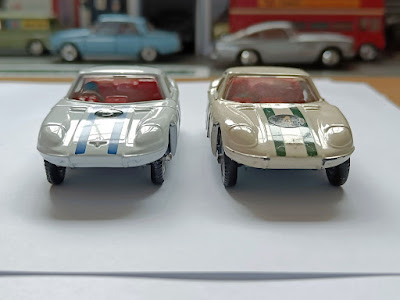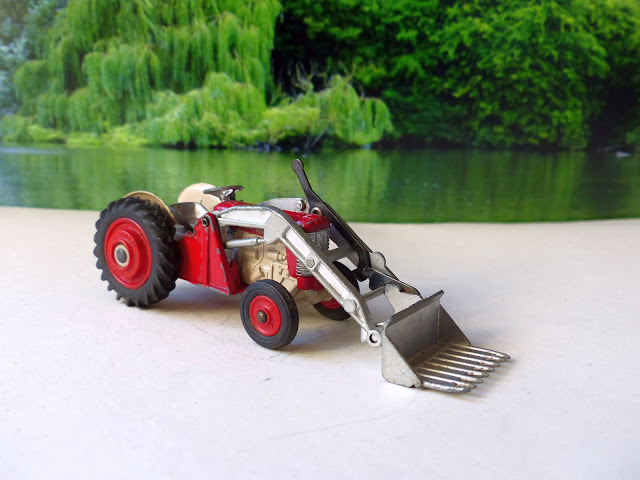"So what's this?" you may well ask! I had a 301 Iso Grifo in pretty clean condition but with collapsed suspension. It was too nice to discard so I had the idea of changing the dreadful Whizzwheels for some nice shaped wheels.
"That'll be easy," I said to myself. "No it won't." could have been a useful reply but, no-one else being around, I just pressed on hopefully.
Taking it apart was simple enough. There were more bits and pieces than I'd expected but nothing too complicated. I can't remember now what had provided the suspension before but, whatever it had been, it wasn't working and I removed what was left. The problem came when I tried to fit normal wheels on a normal old-style axle. Firstly, there was now nothing to provide suspension, of course. I toyed with some ideas of rubber chunks in the right places and even carved out some shapes to sandwich between the axles and the interior at the back and engine at the front. That ought to have worked but it didn't and I gave up. In any event the wheels were not sitting correctly, being way too high in the wheel arches. Eventually I realised that the slots into which the previous axles had sat were not wide enough. They looked wide enough and casual inspection seemed to show the new axles sat nicely in them. More careful inspection, however, showed this not to be the case. The Whizzwheel axles are very thin but the normal old axles are a lot thicker and they just sat at the top of the slot.
With a combination of a small metal saw blade and a very ancient file with a triangular profile I wore away a bigger gap. This took far, far longer than I could ever had imagined but, eventually, the axle dropped in far enough so that the car would look sensible when upright and back together.
Now, at this point I should, perhaps, have revisited my rubber chunks idea but I had had enough. "I'm sorry, Iso", I said, but "no more suspension." As if to answer a plea to reconsider, I continued with "Look, no-one's going to be playing with you. You'll sit on my desk for a few weeks, then maybe on a shelf in a cabinet and then you'll be wrapped in tissue and left in a box for years. I can't see anyone wanting to buy you and I'm not going to spend another 12p a month advertising you on Ebay but I may put you in my own store so that doesn't cost anything. And even if someone does buy you, you'll be sat on their shelf or tucked away again for years. So let's not get too sentimental about suspension, OK?"
And so it was so that I saved another week of carving old rubbers or risking damaging the interior by simply gluing the axle to the base. I do fear someone thumping hard on the roof or bonnet in an attempt to test the non-existent suspension and the glue not standing up to that but no other solution came to mind.
Putting it back together does require a little good fortune in getting the door hinges to align nicely with the base, and there is a correct order to window unit, doors, dashboard, steering wheel, rest of interior which escapes me now, but it worked and here is what, in my view, is a remarkably more attractive model of a splendid car.
This business of replacing wheels is very rewarding. Whizzwheels just scream to be replaced, don't they? Well, the earlier ones do. And that gives me the next idea which is a variation on the theme. Instead of doing battle with axles I could simply try just removing the pepperpots or four crowns (or the really awful six point stars) and refitting a later, more attractive style. Later Corgis did get a more reasonable wheel and that might work. The nice thing is that, with a good tug and a bit of luck, I can swap them over without having to take the model apart!
This, as you may have guessed, brings me to the topic of 'red spot' Whizzwheels. These were the very first and were actually quite a pleasant design that didn't look too bad on some models. There is an Iso Grifo on Ebay at the time of writing with them.
Only £779. Or why not buy the same seller's Toyota for a mere £939?
Both have been created by someone - the old wheels pull off and the red spots push on. It is that simple. Yes, they look interesting and they look a lot nicer than the original wheels but, no, they're only worth, at most, the price of a similar model with the ugly ones. When these models were issued, Corgi were fitting the pepperpot style to their Whizzwheels production, the red spot style being abandoned as it was expensive. There will have been been spare red spot wheels lying around and no doubt some factory people had some fun fitting them too but do not believe that these were issued by Corgi for dealers to order.
I have listed before the models you will find with red spots:
344 Ferrari Dino
347 Chevrolet Astro
343 Pontiac Firebird
303 Roger Clark's Ford Capri
311 Ford Capri
342 Lamborghini P400 Miura
That's it. Treat any others as 'adaptations'.


















